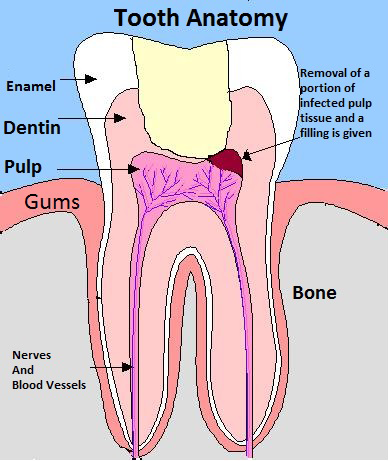A healthy tooth has a space inside it called the "pulp space" which is filled with
soft tissues - nerves, blood vessels and pink connective tissue. If a tooth gets
a large cavity, the bacteria in the decay can damage the pulp, which is often what
causes toothache.

A pulpotomy is the removal of a portion of the pulp, including the diseased aspect,
with the intent of maintaining the vitality of the remaining pulpal tissue by means
of a therapeutic dressing.
Pulpotomy usually is done in children when decay has reached the crown part of the
pulp, but the nerve in the root of the tooth is still healthy. The procedure also
is done when the pulp is exposed as a result of injury or trauma. The affected part
of the pulp can be removed, leaving the healthy part in the root. A successful pulpotomy
relieves sensitivity and pain. It also prevents the supporting tissues around the
tooth from breaking down.
Damage to the pulp of permanent teeth usually requires a Root Canal Treatment or
Endodontic Therapy. The pulp of primary or deciduous teeth, which only have to survive
until an adult tooth comes in, and because they have a better blood supply, can
sometimes be saved.
Indication for Pulpotomy
If the pulp in the crown of a tooth is injured or decayed, but the pulp in the root
is healthy, a pulpotomy may save the nerve inside the root from dying.
For your dentist to do a pulpotomy, the tooth should not be loose or have any swelling
or abscesses around it. If there is swelling or an abscess, another type of treatment
may be needed.
Pulpotomies can be done in children's baby teeth (primary teeth) or in young permanent
teeth. In primary teeth, the procedure is done to keep the primary tooth from being
extracted. Extracting a primary tooth before it is ready to fall out can alter the
way the permanent teeth come in and may cause problems in the future with the child's
bite.
If the pulp of a permanent tooth becomes injured or decayed soon after it emerges,
the tooth may require root canal treatment. However, root canal treatment is not
done until the tooth's roots are finished growing. In this case, a pulpotomy can
be done instead. Root canal treatment can be done after the roots finish developing.
Preparation
X-rays are taken to review the tooth's position and anatomy, and to see whether
the root is infected.
A pulpotomy is done using local anesthesia. Sedation also may be used. This can
include nitrous oxide or an oral medicine. Sedation may help to calm anxious children
or young children who are not able to cooperate.
Pulpotomy Procedure
Primary (baby) teeth in children have relatively large pulp spaces and a cavity
does not have to get very large before it reaches the pulp chamber.
When the soft tissue in the pulp chamber is infected (has bacteria in it) or affected
(is inflamed), it can be removed by a dentist under local anaesthetic. If the soft
tissue in the canals is still healthy enough, a special medicated filling can be
put into the chamber in an attempt to keep the remaining pulp (in the canals) alive.
The process of removing the pulp from the chamber is the actual "pulpotomy," though
the word is often used for the entire process including placement of the medication.
Afterwards the tooth is restored with a regular filling or a stainless steel crown.

Follow-up
- EYour child's gums may be sore in the area. Dr. Kaur will check on the tooth during
future visits.
- EPulpotomy has a high success rate. However, failures and other problems can occur.
- ESome of the medicines used in Pulpotomy can irritate tissues outside of the pulp.
- EYour child might feel a temporary burning sensation in the area of the affected
tooth.
- EIf the tooth's entire nerve is infected, the Pulpotomy may fail. We will look for
infection during the procedure, but if the nerve is in the early stages of infection
it may look healthy.
- EIf the tooth still hurts after Pulpotomy, root canal treatment may be needed. This
will be done to remove the rest of the affected pulp.